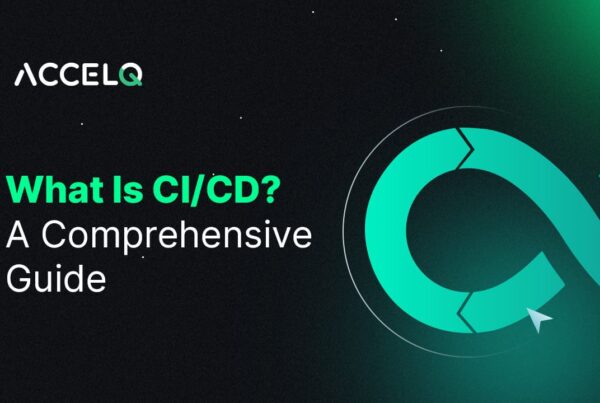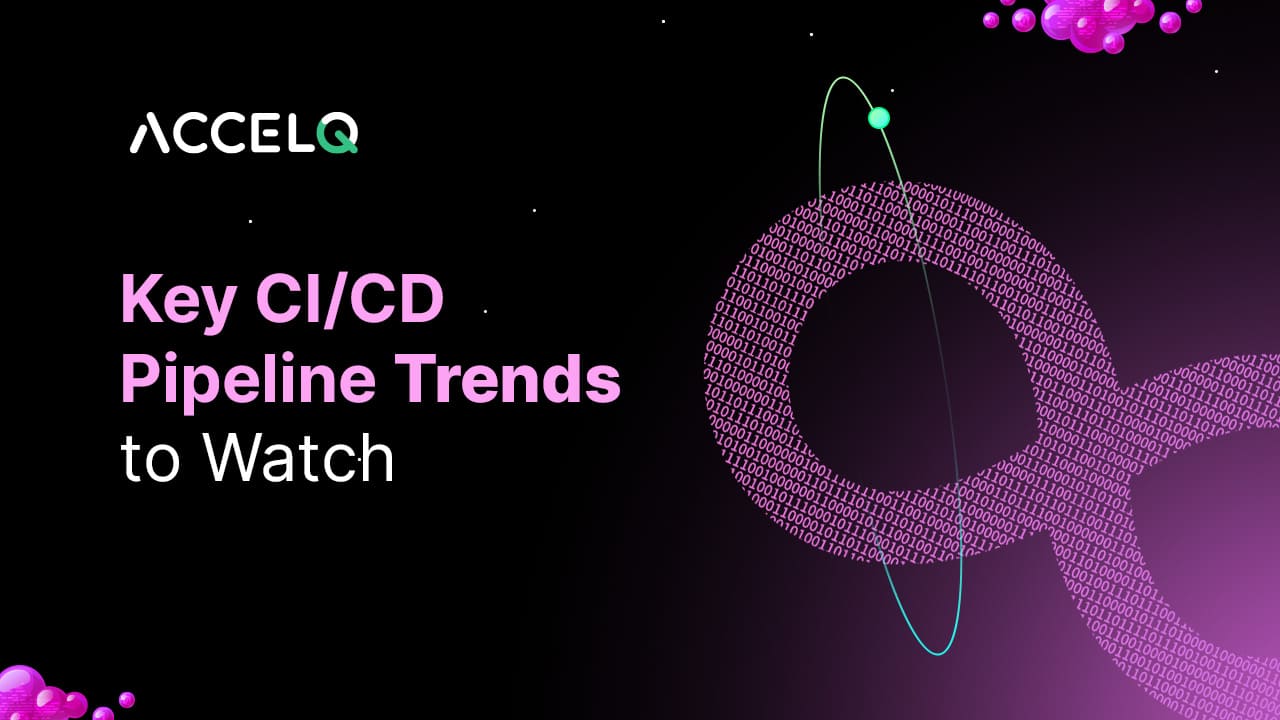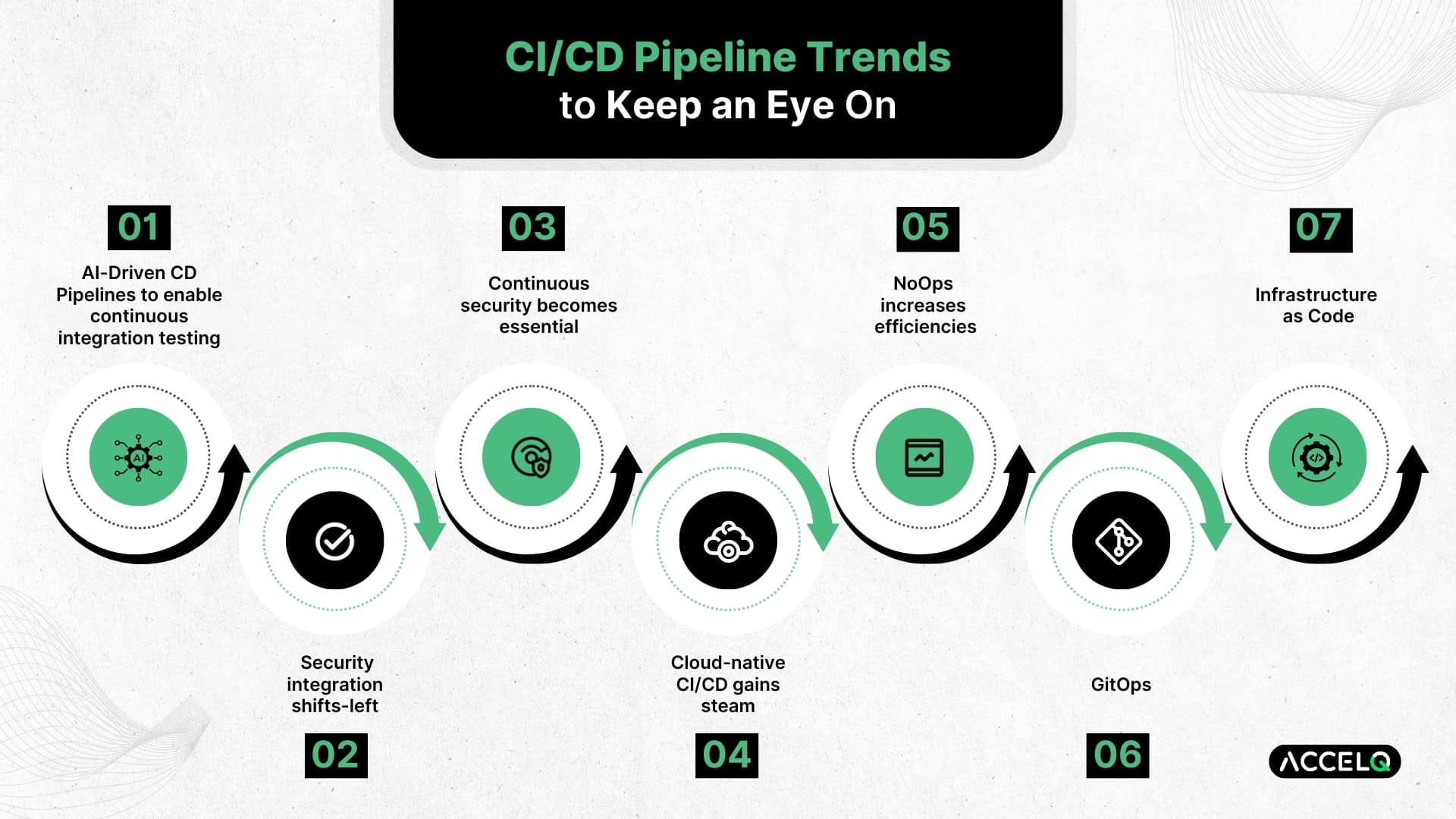Key CI/CD Pipeline Trends to Watch in 2024

CI/CD pipelines are preferred by those wanting to accelerate application delivery and release cycles, contain costs, and reduce development risk.
Accommodating user feedback, increasing responsiveness to market changes and business priorities, and elevating competitiveness depend on application quality. CI/CD emerges as a valuable enabler of development velocity.
As the new year begins, it is time to examine the trends that promise to influence the CI/CD pipelines in the year ahead.
In this blog, we take a look at the top 7 CI/CD trends to watch out for in 2024.
7 CI/CD Pipeline Trends to Keep an Eye On
1. AI-Driven CD Pipelines to enable continuous integration testing
Artificial Intelligence is now set to overhaul CI/CD pipelines as well as further streamline the SDLC. AI-driven CI/CD pipelines enable faster issue detection. They identify bottlenecks and provide potential solutions before developers become aware of the problem.
AI-powered pipelines help development and testing teams drastically reduce the time taken to troubleshoot and debug. This becomes especially beneficial during continuous integration testing as AI accelerates testing.
AI automates routine tasks such as setting up continuous integration testing environment setups. In addition, it drives intelligent automation in the continuous delivery pipeline, automates code reviews, testing, etc., and frees up developers to focus on more complex tasks.
2. Security integration shifts-left
Growing cybersecurity concerns and a rapidly evolving threat landscape demand an increased focus on integrating security into the CI/CD pipelines. In the coming year, security is expected to get more tightly and more comprehensively integrated into continuous delivery pipelines.
Automated security checks, vulnerability planning, and threat modeling are gradually becoming a part of the deployment process. Therefore, security integrations have to shift left in the CI/CD pipelines to help development teams meet the demand for high-quality and highly secure applications.
3. Continuous security becomes essential
Development and testing teams need the support of robust testing tools and practices to embed continuous security across the CI/CD pipelines and the development process. Therefore, robust vulnerability scanning, penetration testing, and code analysis, building secure coding practices, avoiding known vulnerabilities, and using secure libraries to build these pipelines are now taking precedence.
Enhanced monitoring and observability capabilities will also become essential for driving application performance. Teams have started using advanced monitoring tools to get real-time visibility into CI/CD pipelines and access to granular insights into application performance, user behavior, and system health.
4. Cloud-native CI/CD gains steam
Cloud-native CI/CD approaches are increasing to streamline and automate the software delivery pipeline. The rise of container orchestration tools such as Kubernetes is also responsible for the rise of cloud-native CI/CD. These tools allow easy management and deployment of containerized applications – from deployment to production – across different environments.
Cloud-native CI/CD pipelines drive agility and responsiveness to market conditions and ensure faster delivery of new features and bug fixes. They also improve cloud resource utilization and reduce software development, deployment, and delivery costs.
5. NoOps increases efficiencies
The need to accelerate development and make it more streamlined is also going to contribute to the rise of NoOps. NoOps eliminates the need for dedicated operations teams and, instead, allows developers to manage and monitor applications.
CI/CD pipelines will now have to become more robust and enable developers to integrate code changes into shared repositories and deploy those changes to production using automation.
As interest in NoOps increases, CI/CD pipelines have to become stronger for a more streamlined software delivery process. Tools like Jenkins, Ansible, Docker, and Kubernetes, etc. come in handy to manage automation and deployment and allow developers to manage applications and deliver software faster and more efficiently.
6. GitOps
GitOps is also influencing CI/CD pipelines and is allowing developers to use Git repositories as the single source of truth for code and configuration.
Many organizations are implementing GitOps as a part of CI/CD processes to leverage the benefits of speed and efficiency. GitOps allows developers to make changes to code or configurations in a Git repository and gives them the capacity to develop personalized SDLC workflows directly within their GitHub repositories.
The Git-centric workflows allow automated release of incremental updates and allow developers to manage clusters and deliver efficient, safe applications without any misconfigurations.
7. Infrastructure as Code
Infrastructure as Code (IaC) is another trend organizations are observing as they look for ways to streamline software processes for speed and efficiency. IaC removes the need to manage and provision IT infrastructure manually and delivers it as code. It automates infrastructure management and deployment and makes software delivery faster and more accurate.
The role of Infrastructure as Code in Continuous Integration and Continuous Delivery pipelines is set to increase, because,
- It helps eliminate delays associated with infrastructure provisioning needed for continuous integration testing and accelerates the testing process.
- It reduces the time required for bug identification and resolution.
- It enables automated deployments across different environments and empowers development teams to push changes rapidly and consistently.
- It reduces the time from development to production, adapts workloads, provides greater control over infrastructure provisioning, and version-controlling configurations, and ensures consistency in the SDLC process.
How ACCELQ Can Help
CI/CD promotes a continuous feedback loop involving customers and stakeholders throughout development. Reducing cycle times and streamlining the software delivery process allows developers to bring new features, updates, and bug fixes to market more quickly, gaining a competitive advantage and accelerating time-to-market
As such, teams need to ensure that they can set up comprehensively tested, reliable, CI/CD pipelines fast. However, setting up test automation suites, writing automation code, and then testing the same can slow down the process.
ACCELQ’s comprehensive, no-code, AI-powered test automation suite comes to the rescue and enables development teams to infuse agility, flexibility, and scalability into their CI/CD pipelines.
The ACCELQ test automation platform allows development teams to automate all aspects of the quality lifecycle, starting from test design and extending to test planning and execution.
The platform is fit for CI, enterprise-ready, and secure. It offers industry-first virtualized abstraction for functional testing while enabling early, and in-sprint automation.
It provides development teams with a design-first approach with inbuilt modularity, removes the need for custom frameworks, and seamlessly integrates into the existing ecosystem of tools such as Jira, TFS, Jenkins, Bamboo, Circle CI, TeamCity, Azure pipeline, Github, etc.
Continuous integration testing and building a robust continuous delivery pipeline are emerging as enablers of high-quality software. Connect with our experts to leverage the ACCELQ advantage for your CI/CD pipelines.
Nishan Joseph
VP Sales Engineering
Nishan is a tech strategist with expertise in Test Automation and roles at giants like TCS, Microfocus, and Parasoft. At ACCELQ, he champions Strategic Alliances, cultivating global tech partnerships. Educated at Leeds University and Symbiosis Pune, he also possesses an engineering background from Bangalore.
You Might Also Like:
 Jenkins Pipeline: A Complete Guide to CI/CD Success
Jenkins Pipeline: A Complete Guide to CI/CD Success
Jenkins Pipeline: A Complete Guide to CI/CD Success
 CI/CD Pipeline Trends Engineering Teams Must Track Closely
CI/CD Pipeline Trends Engineering Teams Must Track Closely
CI/CD Pipeline Trends Engineering Teams Must Track Closely
 What is a CI/CD Pipeline? A Comprehensive Guide
What is a CI/CD Pipeline? A Comprehensive Guide

































